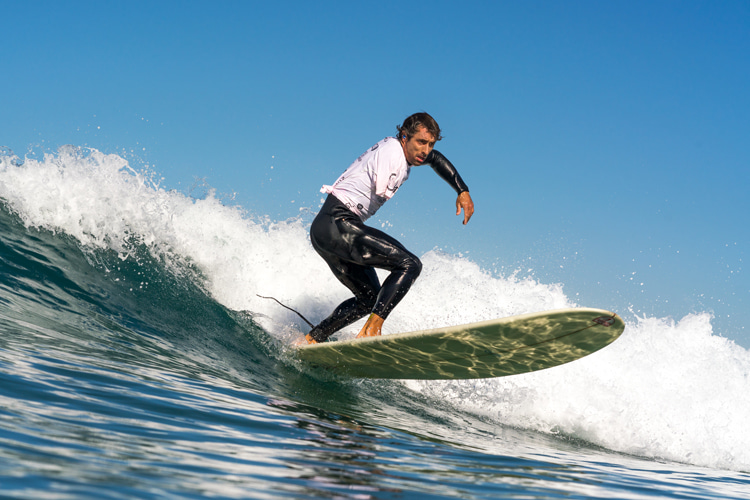Surfing is surfing. Two arms or one, you still must master all the same skills. Learn a few tricks and hints that can help you if you don't have full use of both arms.
In fact, there may be way more people moaning about not being in the water because of an acute or chronic shoulder injury than real one-arm surfers.
Well, with a few hints, you can all be surfing. And to paraphrase Garrett McNamara, "You can make every wave a 100-foot wave."
The first reaction to seeing a one-arm surfer is the flash of trauma. War wound, shark bite, chainsaw - how did that terrible thing happen?
The second thought is a bit of fascination: "I saw that movie. Maybe I'll just look over to see how they do it."
The third is that you are just watching another surfer.
Surfing with one arm is as easy as with two. The big mechanics are the same - paddle out, find a wave, paddle in, pop up, and surf.
Sure, there is less innate paddling power.
Your one arm takes a more active role in balance; getting back on your board requires a little more planning, and sometimes there is a little more patience needed for little things.
The first step could be matching your arm with your stance.
Consequently, right arms will be right foot forward (goofy), and left arms will be left foot forward (regular). After that, your only limit is you.
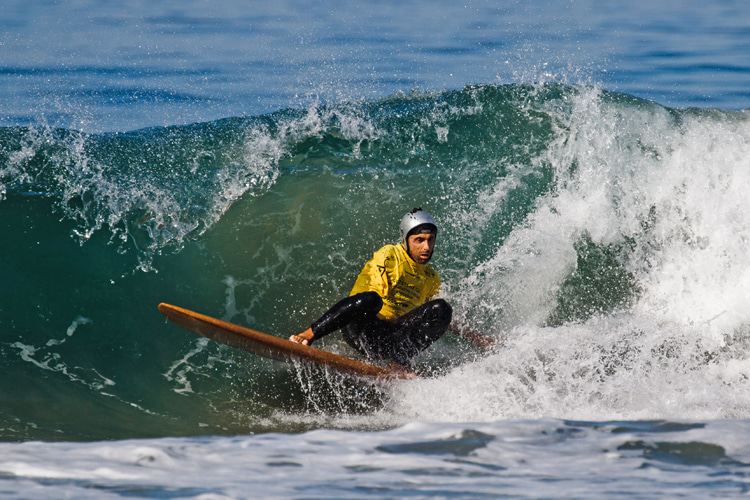
Gear and Preparation
Depending upon the water temperature, a wetsuit will need to be modified.
John Crane, the "King of One Arm Surfing" in Southern California, simply tucks the arm inside the suit and ties it off to prevent water from coming in.
It is a quick and easy modification, especially in the beginning.
The second option is to have the wetsuit modified for your body. While a minor cost is involved, finding a shop that can do the work is the biggest obstacle.
Don Hall at M&B Wetsuits, Long Beach, California, has done all my work.
Although he does repairs, he is an accomplished custom wetsuit builder and has the skills to do anything. I buy mine off the rack and deliver them to him.
Both options work well, but the colder the water and the frequency of sessions may determine what is best.
The second item to consider is the webbed glove.
Darkfin, Sporti, and Body Glove make gloves. I use one glove by TYR, but the brand stopped production in 2021.
Gloves can be found at swimming supply outlets, but those at dive shops may be too bulky.
The glove gives you a lot more paddling power. As one's surfing evolves, there is always the discussion of feel versus power - I have done both.
At first, the glove feels a bit like surfing with booties, but halfway through a session, one forgets about it.
After surfing completely covered in 52 °F (11 °C) water, a glove in Hawaii is a fair trade for catching a great wave.
Board selection, while a matter of personal preference mixed with skill and availability, should, at least in the beginning, point toward having lots of flotation.
There are too many other things to work on, especially with 50 percent of your paddling power gone. If you do not own a longboard, do know that short and thin boards will be hard to start with.
So, ideally, start as a longboarder, work your way down, and stay clear of adding straps or handles to a board until you make significant progress.
You may be told by other surfers that a handle will work well for staying on a board, pushing through a shore break, or when caught in the impact zone.
The last thing you want to do is try to hold on to a twisting board being ripped from you and tearing your only good shoulder apart.
Trust me on this. Bethany Hamilton has a handle on her board for duck diving. It is something she and her father worked on for her.
If you are on a board small enough to duck dive, you probably have enough experience to understand the situation.
Paddling Out
Selecting where and when you surf will determine how easy or hard it will be to paddle out.
Locations with a long shore break or short intervals between waves will be more of a challenge.
Patience is critical. If a couple of big sets come in, it is easier just to wait till things calm down.
Heading out in smaller waves that have already broken, it is easy to do a one-arm push-up and let the water run between you and the board.
With bigger swells that have not broken, I reach out to the rail near the front of the board, where I have applied some extra wax for a good grin, and simply hold on as I ride over the top of the wave.
If I'm going to get hit with the breaking wave, I ditch the board, dive under the wave, cover my head as I come up, and follow the leash.
In the rare instance you are caught in the impact zone of a big set, try to grab as much air as you can and just ride it out.
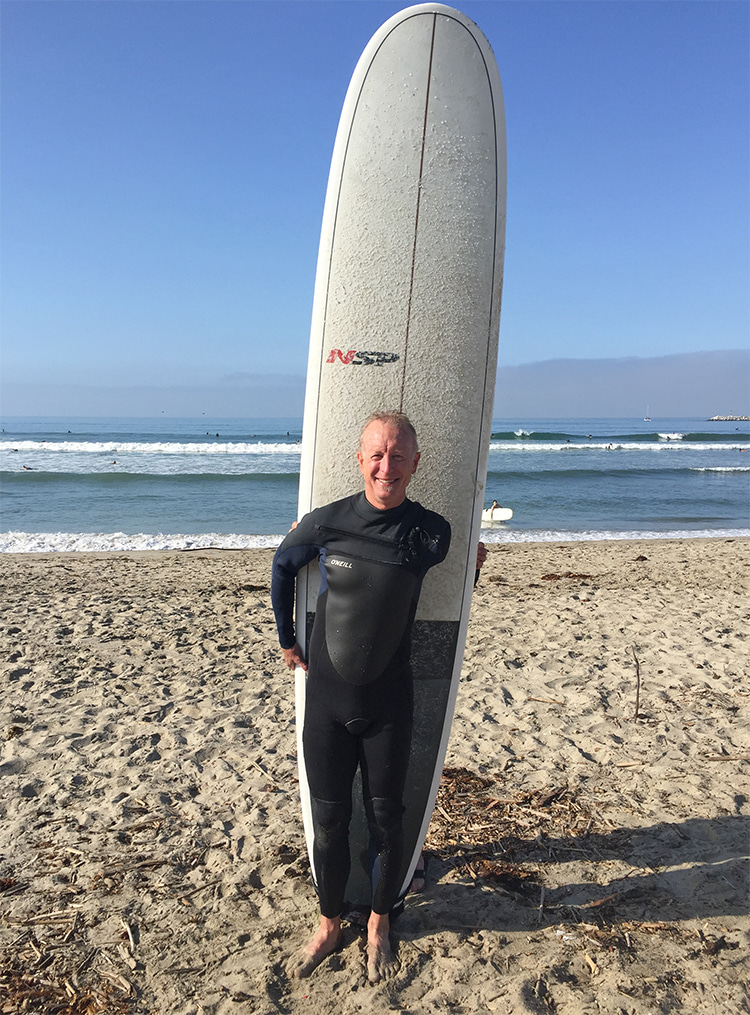
Paddling Into a Wave
Wave selection and paddling into the wave have always been my biggest challenges.
Not living at the beach and starting late in life, I missed out on the many hours it can take to learn how to read waves and develop a feel for being in the right spot.
While traveling to a lot of new places, it has been practical and a treat for me to take advantage of private lessons.
I have some who know the area, or I get a great surf buddy for the day. And I never refuse a shove to get going.
If you can afford it, it is money well spent and a great way to learn more about a region than just the break you are at for the day.
If there's one thing that applies to all surfers is the need to understand what the waves are doing and have a feel for where you are.
Mellow, longer-period swells favored by longboarders are the best place to start.
In the beginning, you will want to start paddling earlier to compensate for the slower paddling speed.
Experienced one-arm surfers sometimes use a late drop to take advantage of the increased steepness of the wave to let it do the work for them and take advantage of the board falling away for a less strenuous pop-up.
They have the skill to take advantage of some bigger swells.
So, I have been working on getting up as soon as possible, and it has really helped on three-to-four-foot beach break closeouts.
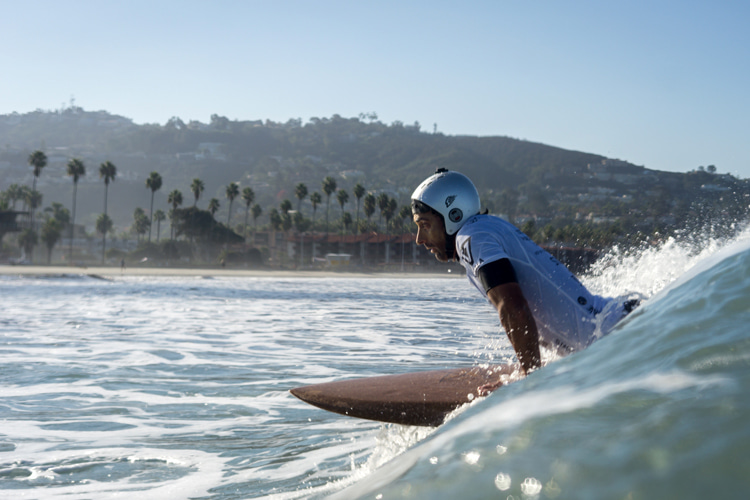
Popping Up
Paddle, paddle, paddle, and pop up. My journey going from two arms to one begins with an intermediate step, which is coming to my knees.
Older surfers, injured surfers, and some very stylish expert women have no problem coming to their feet from being on their knees.
As the wave gives your board that sudden push forward, place your arm across your board just under your chin, keeping your head up and eyes toward the beach.
With enough weight on that arm to raise your head, arch your back, and pull your knees up and under your chest.
Keep your arm in front of you, lift your arm, head, and upper body, and put your lead leg and foot on the board in the same place as if you are popping up.
With 60 percent of your weight on the front leg, unfold your back leg, rotating your foot to match the angle of your front foot.
My preference is to stabilize low in this position - island-style - and then rise to my upright, relaxed stance.
With practice, it becomes quicker, but it is a great way to start and an essential surf skill.
The holy grail of one-arm surfing is the one-arm pop-up.
Since I do not live at the beach and want to keep my head in the game, I train three days a week in the pool and run three days a week.
My pool days are my pop-up days.
After a warm-up swim, I head to the pool deck to stretch and warm-up drills: 20 V-ups, 20 knee push-ups, and five burpees.
Then, I'm back in the pool for a 100-meter swim, like paddling out, and once again back to the pool deck for ten pop-ups.
I repeat the process until I have done a total of 30 pop-ups and finish with a 100-to-200-meter cool-down swim.
The one-arm pop-up is simple.
It begins like a one-arm push-up, with your hand in the middle of the board, anywhere from under your face to the sternum.
Then you push, and you pop up from there, just like with two arms.
After a surgery I had, my back leg lagged a bit, so I just use the front leg to finish getting up.
There is a little more balance that needs to be conquered, but it still has the quickness to get up early enough on the wave and surf beach breaks.
John Crane uses both techniques.
He also advises learning how to set your board up at an angle to the wave so when you are up, you are ready to surf and do not have to immediately crank a big turn.
Being at an angle can also be helpful on small steep waves.
Coming up from your knees can take a little longer, and you risk burying the nose of the board. If you are really late, you can always ride the foam.
One of the older guys at Ala Moana Bowls, on the South Shore of Oahu, rides down the front of bigger waves on his knees and stands up at the bottom to make a big turn.
Even if you must crawl up, the pop-up can be developed in stages from beginner to advanced and still get you on a wave.
On bigger waves, both Crane and Hamilton like a late drop.
The board falls away from you as you pop up, making the first part easier.
And if you have excellent skills, finishing your pop-up at a steep angle on the face of the wave is doable.
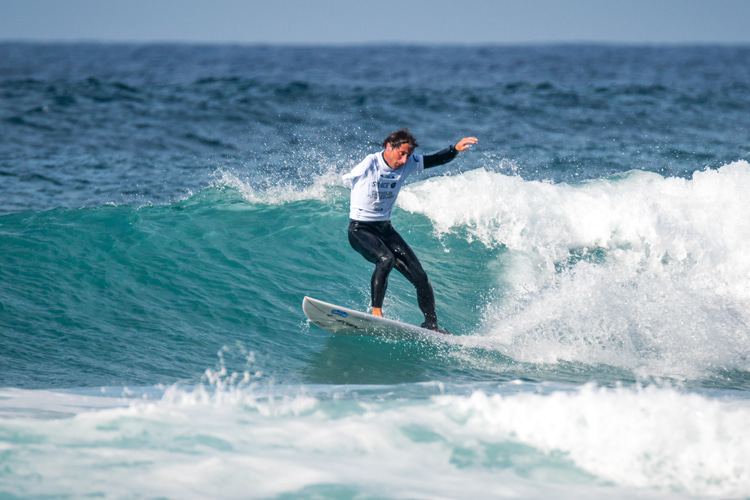
Maneuvering on a Wave
Surfing is surfing, and maneuvering is the simplest and most straightforward part of surfing.
One-arm surfers only differ in exclusively using the front arm to control upper body balance and obviously cannot trail fingers in the barrel.
At this point, when you are working in green water on the face of the wave, it is time to surf like everyone else.
Wiping out and Getting Back on the Board
There are two ways to end a ride: fall off or lower yourself. John Crane has learned to lower himself to his knees and lay back flat.
Strange as it may seem, it is harder to lower yourself than come up. See eccentric weightlifting for the technical details.
Since a lot of my surfing has been in shallow reef breaks, I just end rides by falling flat on my back and keeping a heel on the board.
It saves having to swim or drag the end of the leash.
Getting back up, you grab the opposite rail across your board and simply pull yourself back on the board.
The only difficulty is you need enough water depth to let your legs hang, a problem that usually occurs in shallow water on reefs.
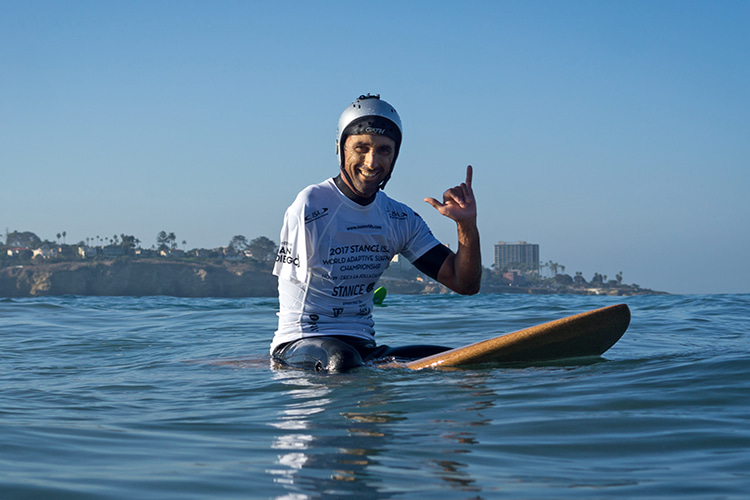
Conditioning
In discussing what we thought were key points to one-arm surfing, John Crane and I both indirectly mentioned conditioning.
You can never be fit enough as a one-arm surfer.
John does a lot of work in the weight room. I swim and do pop-ups three days a week and run three more.
It is important to guard against shoulder injuries by strengthening all the muscle groups in the shoulder area.
Core strength is essential for all surfers. For me, next-level core strength is required for surfing with one arm.
From putting on your wetsuit to taking it off, everything you do surfing will be easier the stronger your core is.
Each one-arm surfer will develop techniques special to themselves and to the conditions they surf.
The great thing is surfing with one arm is easy. It does not take any special gear - simply the desire to surf and learn a few new tricks.
Words by Steve Brown | Adaptive Surfer
